
Gnaphalium uliginosum, the marsh cudweed, is an annual plant found on damp, disturbed ground and tracks. It is very widespread across much of Europe, Asia, and North America. It is very common on damp, arable grasslands, paths, and on acid soils.

Filago is a genus of plants in the sunflower family, native from Europe and northern Africa to Mongolia, Nepal, and Macaronesia. They are sometimes called cottonroses or cudweeds.
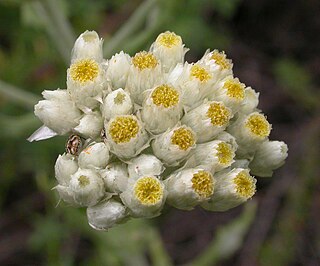
Pseudognaphalium californicum is a species of flowering plant in the family Asteraceae known by several common names, including ladies' tobacco, California rabbit tobacco, California cudweed, and California everlasting.
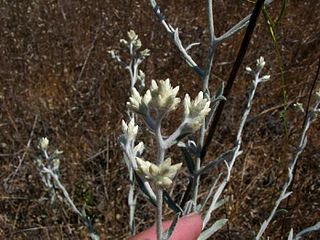
Pseudognaphalium canescens is a species of flowering plant in the family Asteraceae known by the common name Wright's cudweed.

Gnaphalium palustre, known by the common name western marsh cudweed, is a species of flowering plant in the family Asteraceae.

Cirsium discolor, the field thistle, is a North American species of plants in the tribe Cardueae within the family Asteraceae. It is native to thirty-three states in the United States as well four Canadian provinces. It occurs across much of eastern and central Canada as well as eastern and central United States. It has been found from New Brunswick west to Saskatchewan and south as far as Texas and Georgia.

Pseudognaphalium luteoalbum, synonyms including Helichrysum luteoalbum, is a species of flowering plant in the family Asteraceae. In the United Kingdom, it is known the Jersey cudweed.
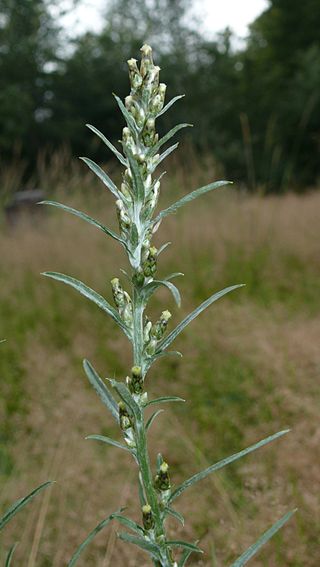
Omalotheca sylvatica, synonyms including Gnaphalium sylvaticum, is a species of plant in the family Asteraceae. It is commonly known as heath cudweed, wood cudweed, golden motherwort, chafeweed, owl's crown, and woodland arctic cudweed. It is widespread across the temperate Northern Hemisphere, throughout North America and Eurasia. The species was first formally described by Carl Linnaeus in 1753 as Gnaphalium sylvaticum.
Gnaphalium exilifolium, the slender cudweed, is a plant species native to the western United States and northern Mexico. It grows in hilly and mountainous regions in the Black Hills, Rocky Mountains, and other ranges from the states of Chihuahua, Colorado, Kansas, South Dakota, Wyoming, Arizona, New Mexico and Utah. It grows in moist locations such as lake shores, stream banks, moist meadows, etc., at elevations of 1,400–3,000 m (4,600–9,800 ft).
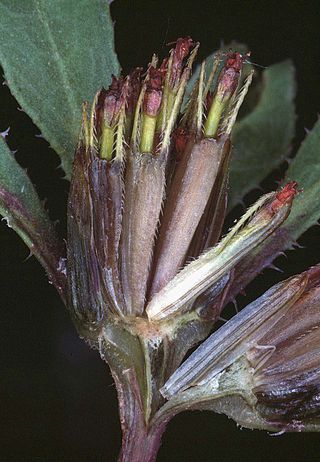
Bidens connata , the purplestem beggarticks or London bur-marigold, is a species of flowering plant in the family Asteraceae. It is widespread across much of Eurasia, North Africa, and North America, and naturalized in Australia and on certain Pacific Islands.
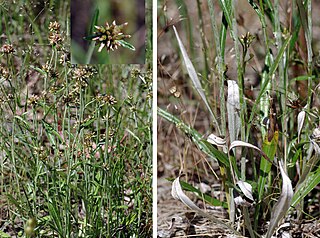
Euchiton collinus, the creeping cudweed, is a herb native to Australia and New Zealand. It has become naturalized in a few places in the United States.

Euchiton involucratus, the common cudweed, is an herb in the tribe Gnaphalieae within the family Asteraceae. It is native to Australia and New Zealand and sparingly naturalized in a few scattered locations in the United States.

Filago pyramidata, the broadleaf cottonrose or broad-leaved cudweed, is a European plant species in the sunflower family. It is native to the Mediterranean region of southern Europe, northern Africa, and the Middle East, plus Great Britain, the Low Countries, and Germany. It is also naturalized in scattered locations in North America and Australia, Pakistan, and other places.

Gamochaeta coarctata, the gray everlasting, is a species of flowering plant in the family Asteraceae. It is widespread in South America and naturalized in parts of Eurasia, Australia, and North America.
Gamochaeta argyrinea, the silvery cudweed or silvery everlasting, is a North American species of flowering plant in the family Asteraceae. It is widespread across the southeastern and south-central United States from Delaware south to Florida and west as far as southeastern Kansas and central Texas. It has also been found in Puerto Rico and in northern California.
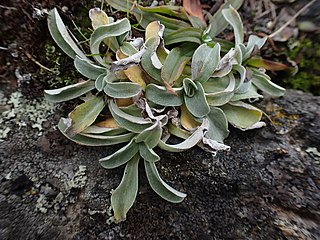
Gamochaeta ustulata, commonly named featherweed or Pacific cudweed, is a North American species of flowering plant in the family Asteraceae. It is native to the western United States and southwestern Canada, in British Columbia, Washington, Oregon, and California. It is found primarily on seaside hills and in the Coast Ranges, with additional populations inland.
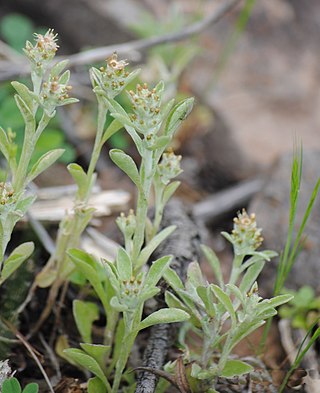
Gamochaeta pensylvanica, the Pennsylvania cudweed or Pennsylvania everlasting, is a widespread species of flowering plant in the family Asteraceae. It is native to South America and introduced into Eurasia, Africa, Australia, and North America. The pensylvanica epithet is a misnomer, as the plant is not native to Pennsylvania and only marginally naturalized there.
Gamochaeta simplicicaulis, the simple-stem cudweed or simple-stem everlasting, is a species of flowering plant in the sunflower family. It is native to South America and has become naturalized in Australia, New Zealand, and the southeastern United States.

Gnaphalium polycaulon, the many stem cudweed, is a plant species in the family Asteraceae. It is widespread across much of Mesoamerica, South America, and the West Indies, and naturalized in parts of Asia and Africa.

Hieracium triste, commonly known as woolly hawkweed, is a species of flowering plant. It is native to North America where it is widespread across western Canada and the western United States from Alaska, Yukon, and the Northwest Territories south as far as California and New Mexico.

















